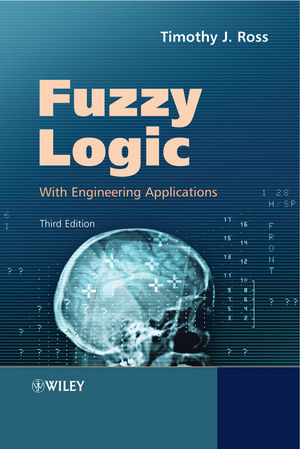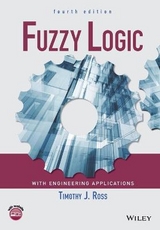
Fuzzy Logic with Engineering Applications
Wiley-Blackwell (Verlag)
978-0-470-74376-8 (ISBN)
- Titel erscheint in neuer Auflage
- Artikel merken
The first edition of Fuzzy Logic with Engineering Applications (1995) was the first classroom text for undergraduates in the field. Now updated for the second time, this new edition features the latest advances in the field including material on expansion of the MLFE method using genetic algorithms, cognitive mapping, fuzzy agent-based models and total uncertainty. Redundant or obsolete topics have been removed, resulting in a more concise yet inclusive text that will ensure the book retains its broad appeal at the forefront of the literature. Fuzzy Logic with Engineering Applications, 3rd Edition is oriented mainly towards methods and techniques. Every chapter has been revised, featuring new illustrations and examples throughout. Supporting MATLAB code is downloadable at www.wileyeurope.com/go/fuzzylogic. This will benefit student learning in all basic operations, the generation of membership functions, and the specialized applications in the latter chapters of the book, providing an invaluable tool for students as well as for self-study by practicing engineers.
Professor Timothy J. Ross is a registered professional engineer with over 30 years experience in the fields of computational mechanics, hazard survivability, structural dynamics, structural safety, stochastic processes, risk assessment, and fuzzy systems. He has been an engineering educator at the University of New Mexico (UNM) since 1987 and is the founding Editor-in-Chief of the International Journal of Intelligent and Fuzzy Systems.
About the Author. Preface to the Third Edition. 1 Introduction. The Case for Imprecision. A Historical Perspective. The Utility of Fuzzy Systems. Limitations of Fuzzy Systems. The Illusion: Ignoring Uncertainty and Accuracy. Uncertainty and Information. The Unknown. Fuzzy Sets and Membership. Chance Versus Fuzziness. Sets as Points in Hypercubes. Summary. References. Problems. 2 Classical Sets and Fuzzy Sets. Classical Sets. Operations on Classical Sets. Properties of Classical (Crisp) Sets. Mapping of Classical Sets to Functions. Fuzzy Sets. Fuzzy Set Operations. Properties of Fuzzy Sets. Alternative Fuzzy Set Operations. Summary. References. Problems. 3 Classical Relations and Fuzzy Relations. Cartesian Product. Crisp Relations. Cardinality of Crisp Relations. Operations on Crisp Relations. Properties of Crisp Relations. Composition. Fuzzy Relations. Cardinality of Fuzzy Relations. Operations on Fuzzy Relations. Properties of Fuzzy Relations. Fuzzy Cartesian Product and Composition. Tolerance and Equivalence Relations. Crisp Equivalence Relation. Crisp Tolerance Relation. Fuzzy Tolerance and Equivalence Relations. Value Assignments. Cosine Amplitude. Max Min Method. Other Similarity Methods. Other Forms of the Composition Operation. Summary. References. Problems. 4 Properties of Membership Functions, Fuzzification, and Defuzzification. Features of the Membership Function. Various Forms. Fuzzification. Defuzzification to Crisp Sets. -Cuts for Fuzzy Relations. Defuzzification to Scalars. Summary. References. Problems. 5 Logic and Fuzzy Systems. Part I Logic. Classical Logic. Proof. Fuzzy Logic. Approximate Reasoning. Other Forms of the Implication Operation. Part II Fuzzy Systems. Natural Language. Linguistic Hedges. Fuzzy (Rule-Based) Systems. Graphical Techniques of Inference. Summary. References. Problems. 6 Development of Membership Functions. Membership Value Assignments. Intuition. Inference. Rank Ordering. Neural Networks. Genetic Algorithms. Inductive Reasoning. Summary. References. Problems. 7 Automated Methods for Fuzzy Systems. Definitions. Batch Least Squares Algorithm. Recursive Least Squares Algorithm. Gradient Method. Clustering Method. Learning From Examples. Modified Learning From Examples. Summary. References. Problems. 8 Fuzzy Systems Simulation. Fuzzy Relational Equations. Nonlinear Simulation Using Fuzzy Systems. Fuzzy Associative Memories (FAMS). Summary. References. Problems. 9 Decision Making with Fuzzy Information. Fuzzy Synthetic Evaluation. Fuzzy Ordering. Nontransitive Ranking. Preference and Consensus. Multiobjective Decision Making. Fuzzy Bayesian Decision Method. Decision Making Under Fuzzy States and Fuzzy Actions. Summary. References. Problems. 10 Fuzzy Classification. Classification by Equivalence Relations. Crisp Relations. Fuzzy Relations. Cluster Analysis. Cluster Validity. c-Means Clustering. Hard c-Means (HCM). Fuzzy c-Means (FCM). Fuzzy c-Means Algorithm. Classification Metric. Hardening the Fuzzy c-Partition. Similarity Relations from Clustering. Summary. References. Problems. 11 Fuzzy Pattern Recognition. Feature Analysis. Partitions of the Feature Space. Single-Sample Identification. Multifeature Pattern Recognition. Image Processing. Summary. References. Problems. 12 Fuzzy Arithmetic and the Extension Principle. Extension Principle. Crisp Functions, Mapping, and Relations. Functions of Fuzzy Sets Extension Principle. Fuzzy Transform (Mapping). Practical Considerations. Fuzzy Arithmetic. Interval Analysis in Arithmetic. Approximate Methods of Extension. Vertex Method. DSW Algorithm. Restricted DSW Algorithm. Comparisons. Summary. References. Problems. 13 Fuzzy Control Systems. Control System Design Problem. Control (Decision) Surface. Assumptions in a Fuzzy Control System Design. Simple Fuzzy Logic Controllers. Examples of Fuzzy Control System Design. Aircraft Landing Control Problem. Fuzzy Engineering Process Control. Classical Feedback Control. Fuzzy Control. Fuzzy Statistical Process Control. Measurement Data Traditional SPC. Attribute Data Traditional SPC. Industrial Applications. Summary. References. Problems. 14 Miscellaneous Topics. Fuzzy Optimization. One-Dimensional Optimization. Fuzzy Cognitive Mapping. Concept Variables and Causal Relations. Fuzzy Cognitive Maps. Agent-Based Models. Summary. References. Problems. 15 Monotone Measures: Belief, Plausibility, Probability, and Possibility. Monotone Measures. Belief and Plausibility. Evidence Theory. Probability Measures. Possibility and Necessity Measures. Possibility Distributions as Fuzzy Sets. Possibility Distributions Derived from Empirical Intervals. Deriving Possibility Distributions from Overlapping Intervals. Redistributing Weight from Nonconsonant to Consonant Intervals. Comparison of Possibility Theory and Probability Theory. Summary. References. Problems. Index.
| Zusatzinfo | Illustrations |
|---|---|
| Verlagsort | Hoboken |
| Sprache | englisch |
| Maße | 177 x 243 mm |
| Gewicht | 968 g |
| Themenwelt | Mathematik / Informatik ► Mathematik ► Angewandte Mathematik |
| Technik ► Elektrotechnik / Energietechnik | |
| Technik ► Maschinenbau | |
| ISBN-10 | 0-470-74376-X / 047074376X |
| ISBN-13 | 978-0-470-74376-8 / 9780470743768 |
| Zustand | Neuware |
| Informationen gemäß Produktsicherheitsverordnung (GPSR) | |
| Haben Sie eine Frage zum Produkt? |
aus dem Bereich



